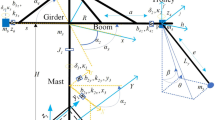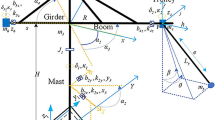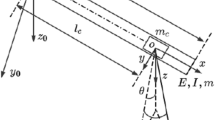Abstract
The present research aims to investigate parametrically the structural vibration analysis of tower crane under the lifting-luffing coupling condition. Structural vibration greatly affects tower crane stability. The structural dynamics of a crane should be considered for studying motion behavior and vibration feature. The dynamic model of the tower crane is presented based on air resistance, boom deflection, and Lagrange equation under the lifting-luffing coupling condition. The vibration model of the tower crane was validated by an experiment. The experiment was conducted with an accelerating speed until reaching the constant speed and then with decelerating speed. This study analyses structural parameters to acquire the dynamic characteristics and vibration features of the tower crane under the compound working condition. The vibration responses of the mast and the boom are studied with frequency- and time-domain indicators. Results show that payload mass, luffing acceleration, boom length, mast height, and girder length significantly influence the mast vibration. In comparison, payload mass, trolley acceleration, and boom length affect the boom vibration. This research can improve the design of a dynamic system for tower crane safety.
Similar content being viewed by others
References
C. R. Gao et al., Study on the parallel solution of finite element analysis of the tower crane under multiple working load cases, Mech. Des. Manul, 3(3) (2019) 242–247.
F. Ju et al., Dynamic response of tower crane induced by the pendulum motion of the payload, Int. J. Solids Struct., 43(2) (2006) 376–389.
L. F. Yu, Calculation method and control value of static stiffness of tower crane, J. Mech. Sci. Technol., 22(5) (2008) 829–834.
J. F. Lei et al., Modeling and modal analysis of the whole structure of PT7032 tower crane based on finite element method, Advanced Materials Research, 706–708 (2013) 1433–1436.
Y. Ushio, T. Saruwatari and Y. Nagano, A new design method for site-joints of the tower crane mast by non-linear FEM analysis, Adv. Comput. Des., 4(4) (2019) 343–365.
L. Zhao, Y. Qin and L. Zhang, Research on jib performance of crane in hoisting wind generator, J. Fail. Anal. Prev., 20(5) (2020) 1794–1802.
H. Kenan and O. Azeloglu, Design of scaled down model of a tower crane mast by using similitude theory, Eng. Struct., 220 (2020) 110985.
Y. Fenglin et al., The relationship between eccentric structure and super-lift device of all-terrain crane based on the overall stability, J. Mech. Sci. Technol., 34(6) (2020) 2365–2370.
Q. Jiao et al., Modeling and optimization of pulling point position of luffing jib on portal crane, Math. Probl. Eng., 2021 (2021) 4627257.
V. B. Nguyen et al., Seismic response investigation of 1/20 scale container crane through shake table test and finite element analysis, Ocean Eng., 234 (2021) 109266.
Y. Wang et al., The influence of the inclination of lattice columns on the safety of combined tower crane, Adv. Civ. Eng., 2022 (2022).
B. Jerman and J. Kramar, A study of the horizontal inertial forces acting on the suspended load of slewing cranes, Int. J. Mech. Sci., 50(3) (2008) 490–500.
E. Maleki and W. Singhose, Dynamics and control of a small-scale boom crane, J. Comput. Nonlinear Dynam., 6(3) (2011) 031015.
O. Gaidai et al., Offshore crane non-linear stochastic response: novel design and extreme response by a path integration, Ships Offshore Struct., 17(6) (2021) 1294–1300.
W. He, Vertical dynamics of a single-span beam subjected to moving mass-suspended payload system with variable speeds, J. Sound Vib., 418 (2018) 36–54.
J. P. Gu et al., Research on dynamic characteristics of composite towering structure, Int. J. Appl. Mech., 13(8) (2021) 2150096.
Y. Chu et al., Coupling of dynamic reaction forces of a heavy load crane and ship motion responses in waves, Ships Offshore Struct., 16(1) (2021) 58–67.
F. Liu et al., Swing characteristics and vibration feature of tower cranes under compound working condition, Shock Vib., 2021 (2021) 1–16.
R. Feng, E. Zhang and M. Dong, Jib vibration and payload swing of tower cranes in the case of trolley motion, Arab. J. Sci. Eng., 46(12) (2021) 12179–12191.
B. Zhou et al., Hybrid compound function/subinterval perturbation method for kinematic analysis of a dual-crane system with large bounded uncertainty, J. Comput. Nonlinear Dyn., 16(1) (2021) 014501.
Y. X. Qin et al., Vibration analysis and control of nuclear power crane with MRFD, Int. J. Appl. Mech., 10(8) (2018) 1850093.
N. Sun et al., Nonlinear motion control of complicated dual rotary crane systems without velocity feedback: design, analysis, and hardware experiments, IEEE Trans. Autom. Sci. Eng., 17(2) (2020) 1017–1029.
V. Loveikin et al., Optimal control of simultaneous tower crane slewing and trolley movement, J. Theor. Appl. Mech., 51(4) (2021) 421–436.
F. Rauscher and O. Sawodny, Modeling and control of tower cranes with elastic structure, IEEE Trans. Control Syst. Technol., 29(1) (2021) 64–79.
H.-T. Shi et al., Nonlinear antiswing control of underactuated tower crane based on improved energy function, Int. J. Control Autom. Syst., 19(12) (2021) 3967–3982.
S. He, K. Chen, E. Xu, M. Ye and Y. Wang, Coupling analysis and optimization of commercial vehicles cab comfort with multi-platform integrated calculation, J. Mech. Sci. Technol., 35(10) (2021) 4329–4341.
J. W. Yang et al., Influence of wheel flat on railway vehicle helical gear system under traction/braking conditions, Eng. Fail. Anal., 134 (2022) 106022.
Acknowledgments
This work was partly supported by the Natural Science Foundation of Beijing Municipal of China under Grant L211008 and KZ202010016025, the Open Research Fund Program of the Beijing Engineering Research Center of Monitoring for Construction Safety of China under Grant BJC2020K002, and the National Natural Science Foundation of China under Grant 51975038.
Author information
Authors and Affiliations
Corresponding author
Additional information
Jianwei Yang received his Ph.D. degree in vehicle operation engineering from the China Academy of Railway Sciences in Beijing, China, in 2006. He is currently a Part-time Professor in the School of Mechanical, Electronic, and Control Engineering of the Beijing Jiaotong University in Beijing. He is also a Full-time Professor in the School of Mechanical-Electronic and Vehicle Engineering of the Beijing University of Civil Engineering and Architecture in Beijing. His research interests include system dynamics, VR, control, and fault diagnosis.
Fu Liu is currently pursuing a Ph.D. degree in intelligent construction engineering from the School of Civil and Transportation Engineering at the Beijing University of Civil Engineering and Architecture in Beijing, China. His research interests include structural dynamics and nonlinear oscillation.
Jinhai Wang received a Ph.D. degree in vehicle operation engineering from the Beijing Jiaotong University in Beijing, China, in 2020. He also received M. Eng. and B. Eng. degrees in vehicle operation engineering and mechanical engineering from the Beijing University of Civil Engineering and Architecture in Beijing, China, in 2015 and 2012. In the summer of 2011, he was a visiting student at the Gyeonggi College of Science and Technology in Sinhyeon, South Korea. He is currently a postdoctoral research fellow at the Faculty of Vehicle Engineering at the Beijing University of Civil Engineering and Architecture in Beijing, China. His research interests include nonlinear oscillation and system reliability engineering.
Changdong Liu received his MASc degree in 2018 from the University of Windsor in Windsor, Ontario, Canada. His research interests include multibody dynamics and structural dynamics.
Xiaohui Wang is currently pursuing her Ph.D. degree in intelligent construction engineering from the School of Civil and Transportation Engineering at the Beijing University of Civil Engineering and Architecture in Beijing, China. Her research interest includes structural analysis.
Rights and permissions
About this article
Cite this article
Liu, F., Yang, J., Wang, J. et al. Effect on tower crane structural vibration under the lifting-luffing coupling condition. J Mech Sci Technol 37, 4935–4947 (2023). https://doi.org/10.1007/s12206-023-0702-4
Received:
Revised:
Accepted:
Published:
Issue Date:
DOI: https://doi.org/10.1007/s12206-023-0702-4




